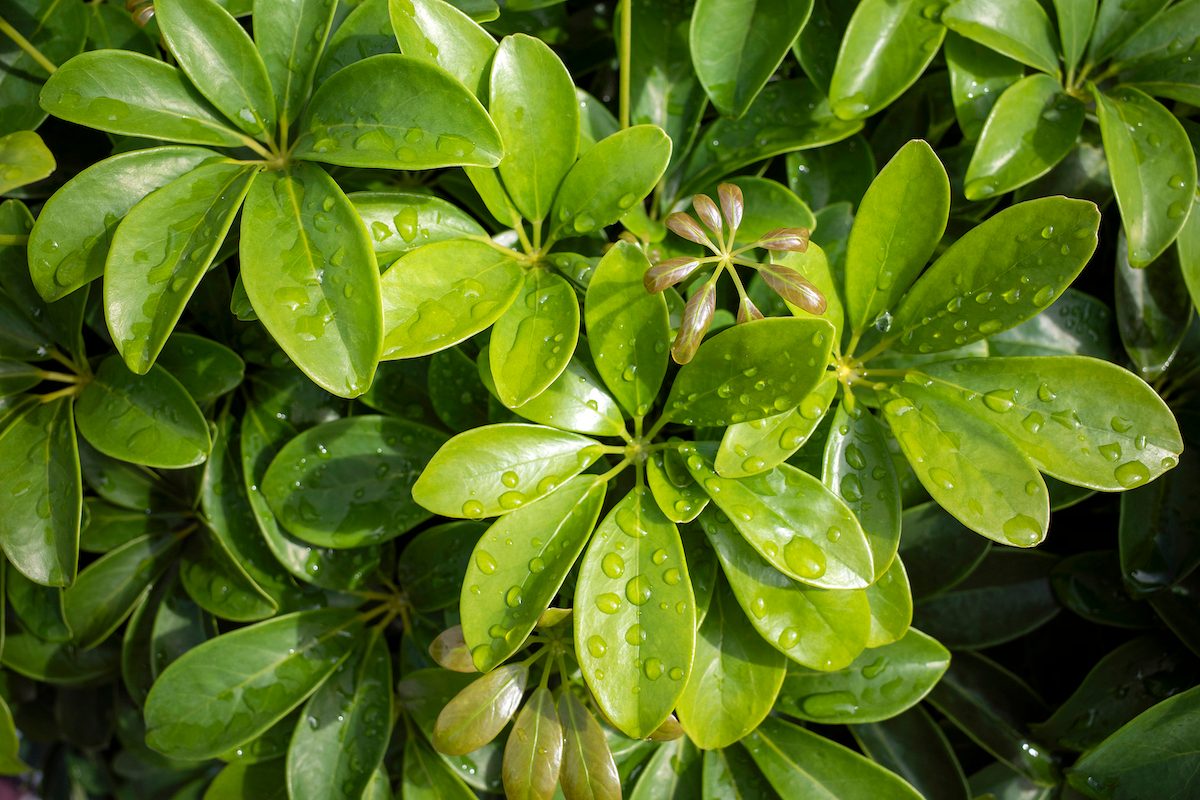Dwarf umbrella trees make ideal houseplants, with shiny green foliage and minimal care requirements. Here's how to ensure they thrive.

Umbrella Plant (Schefflera) Care and Growing Tips

On This Page
What Is an Umbrella Plant?

- Common names: Umbrella plant, dwarf umbrella tree
- Scientific name: Heptapleurum arboricola (previously known as Schefflera arboricola)
- Zones: 9b to 12, or as a houseplant
- Light needs: Bright, indirect light
- Preferred soil: Well-draining soil mix
- Size: 10 to 15 feet tall, 6 to 15 feet wide (smaller in containers)
Indoor gardeners looking for small trees to grow in containers love schefflera, also known as dwarf umbrella tree or umbrella plant. “Schefflera is prized for its clusters of glossy, oval-shaped leaves arranged in a circular pattern, resembling an umbrella,” says Paris Lalicata, head of plant education and community at The Sill. “Its vibrant green foliage, with some varieties showcasing variegated or golden accents, adds a lively, tropical charm to any indoor space.”
This small tropical tree hails from China, Hainan Province and Taiwan, and is a close cousin of the Australian umbrella tree (H. actinophyllum), which grows much taller and is best suited to outdoor gardens in areas where it’s not considered invasive.
Do Umbrella Plants Have Flowers?
When grown outdoors, both types of schefflera flower in the summer months, sporting clusters of small white, red, or pink blooms known as an inflorescence. However, when grown indoors, they rarely flower outside the tropics.
Is an Umbrella Plant Toxic to Pets?
Yes, the sap of schefflera can be harmful for household pets and children. Chewing on the leaves or other plant parts can cause swelling and irritation in the mouth and face, digestive upset, and itchy skin. If you believe your pet has accidentally been exposed, contact your vet and call poison control for children.
Benefits of Schefflera as Houseplants
Paris advises plant parents to consider schefflera because of its easy-going reputation. “Its forgiving nature makes it ideal for various home environments, and beginners and experts alike,” she promises.
Because most gardeners don’t live in the tropical zones where this plant thrives, growing it in a container allows everyone to enjoy the attractive foliage up close. You can move the plant outdoors in summer to enjoy some natural humidity, but remember to shelter it from direct sunlight.
Check out the top 10 best houseplants for beginners to grow.
How to Grow Schefflera in a Container

Choose a container with good drainage holes and use a potting mix specially formatted to be well-draining. When it’s time to upgrade, Paris recommends choosing a pot 1 to 2 inches larger in diameter.
“Don’t repot too soon,” she advises. “While schefflera are fast-growing they do have a shallow root system, which means they can last up to 2 to 3 years or possibly longer in the same container. Repotting your umbrella plant too soon can lead to a higher volume of soil around a small root ball. This may cause watering inconsistencies and even keep the roots too moist.”
Keys for Growing Schefflera Successfully
One of the most important things to note is that an umbrella plant loves bright indirect light but cannot tolerate direct sun. This is especially true in the afternoon, though Paris notes it can tolerate some morning sun from an east-facing window. Keep it in a bright spot, away from the sun’s direct rays.
“Water your schefflera once most of the soil has dried out between waterings, but refrain from overwatering or letting it remain dry for too long,” Paris advises. “When dehydrated, the leaves will start to look pale, curl inwards, and droop over. If overwatered, leaf drop and yellowing may occur.”
Like most tropical plants, schefflera likes humid conditions and temperatures above 60 degrees F. If your home gets very dry due to winter heat, place a humidifier nearby. You can also rest the container on a shallow dish of pebbles filled with water. Make sure the pot rests above the water to avoid root rot.
Umbrella Plant Maintenance and Pitfalls
Be cautious about fertilizing. “Too much fertilizer can lead to salt buildup in the soil and damage the plant,” warns Paris. She recommends following the application rates for your chosen fertilizer, and only feeding your dwarf umbrella tree during the spring and summer growing months.
One final tip from the expert: “Get in the habit of pruning off leggy or overgrown stems. This helps to maintain the schefflera’s shape over time and keep it healthy looking. During the growing season, you can also prune off growth tips which will help to encourage bushier growth to create a fuller looking tree as it ages. As long as you provide the necessary requirements, schefflera is easy-going and will grow into a vigorous plant!” Paris says.
Next, learn how to care for a peace lily plant.
Sources
- University of Florida IFAS – Schefflera arboricola: Dwarf Schefflera
- The Sill – How to Care for a Schefflera
- University of Florida IFAS – Schefflera actinophylla: Schefflera
- ASPCA – Schefflera
About the Expert
Paris Lalicata, head of plant education and community, has been with The Sill for six years and is a self-taught plant expert with over 10 years of experience growing houseplants. When she’s not tending to her indoor garden in the northeast, she is studying to become a certified sustainable gardener while also completing her associates degree in horticultural science. Her passion is making plant care more digestible for budding plant parents, sharing the benefits of indoor plants, and promoting sustainable outdoor gardening practices that nurture nature.





















